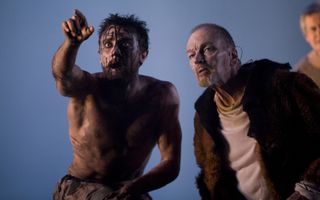
In this task, students practice staging a few lines from King Lear. They consider the ways that sound, lighting, and set influence meaning and tone, and how minimal technology is needed to create an atmosphere. Students also engage in language analysis, considering how features such as imagery, onomatopoeia, punctuation, and personification reveal the emotions of the characters.
One of the most iconic scenes of King Lear is Act 3, Scene 2. In this scene, Lear is outside in the middle of a storm, and he speaks the following lines:
Blow, winds, and crack your cheeks! rage! blow!
You cataracts and hurricanoes, spout
Till you have drench'd our steeples, drown'd the cocks!
You sulphurous and thought-executing fires,
Vaunt-couriers to oak-cleaving thunderbolts,
Singe my white head! And thou, all-shaking thunder,
Smite flat the thick rotundity o' the world!
Crack nature's moulds, an germens spill at once,
That make ingrateful man!
1. In groups, read through the above lines and discuss:
- The tone of the speech, and how it sets the scene.
- The language techniques that Shakespeare is using, and how they affect the tone.
- How you think these lines should be delivered by an actor. (Consider what Lear’s posture might be, where he is looking, what his voice might sound like, how he moves around the stage, etc. Remember, Lear does not have to be standing still in this scene!)
2. In your groups, you are now going to stage these lines. Pick one person to be the performer (or you can take turns), and the rest of you will be in charge of set and lighting design.
In Shakespeare’s England, only limited sound and lighting effects were available. To imitate the sound of a storm, thunder was created by drums, or by rolling a cannonball on a metal sheet. Lighting was created using small fireworks, called squibs. Likewise, set and props were almost non-existent; audience members mostly imagined what the scenery looked like.
Like Shakespeare’s players, you won’t have the resources of a modern professional theatre available to you. This is where you can get inventive. Think about the kind of soundscape that you might need to create to perform this scene. Do you need thunder? Lightning? Wind? How can you create that soundscape? What is the most effective way to evoke these effects with minimal technology? Consider how and when you will use these effects: does the sound of the storm need to continue unbroken throughout Lear’s speech, or will certain effects occur in response to specific lines? Think about how the use of sound and lighting will influence the tone of the scene, and try to find a way for them to support and frame what Lear is saying, rather than drowning out his words.
The same goes for set. Shakespeare does not tell us where this scene occurs, apart from indicating that it is outdoors during a storm. Many directors and editors have set it on an empty heath, but this is not the only staging option. Do you need anything else on stage to set the tone? Are there trees or rocks on the stage with Lear? How does your set influence the tone of the scene?
Combine your initial analysis of the speech with your set, lighting, and sound design, to create a staged version of the lines. Perform your version to your classmates, and discuss the similarities and differences between each version. Did some staging decisions influence tone and meaning in different ways to others?




